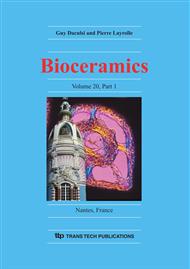p.3
p.7
p.11
p.15
p.19
The Effect of Reaction Conditions on Hydroxyapatite Particle Morphology and Applications to the Reticulated Foam Method of Scaffold Production
Abstract:
The production of nano-scale hydroxyapatite (HA) suspensions to be used for the reticulated foam method of scaffold production was investigated at temperatures of between 10 and 60OC. An increase in reaction temperature was associated with an increase in the particle size and some decrease in the aspect ratio of the particles. Pre-treatment of the polyurethane foam template using PPDS (potassium peroxodisulfate) solution resulted in a significantly improved coating of HA when compared to the untreated samples or those treated with ethanol. Initial trials coating the polyurethane with HA produced at the different reaction temperatures showed a superior coating with the suspension produced at 10OC compared to that at 60OC. A scaffold was produced using the HA suspension produced at room temperature, but further understanding of the suspension properties and the optimum conditions for coating of the PU foam are required for improved mechanical performance.
Info:
Periodical:
Pages:
3-6
Citation:
Online since:
November 2007
Authors:
Keywords:
Price:
Сopyright:
© 2008 Trans Tech Publications Ltd. All Rights Reserved
Share:
Citation:


